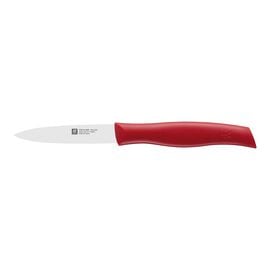Paring Knives
A paring knife is a small, versatile kitchen knife with a blade typically between 3 to 4 inches long. It's primarily used for peeling, slicing, and other precise tasks like deveining shrimp or removing seeds from fruits.
While a paring knife can be used for chopping small vegetables or fruits, it is not ideal for large chopping tasks due to its small size. It's best suited for more delicate or precise work.
In most cases, fruit and vegetables have a difficult consistency for cutting: often thin skin surrounds a mostly pliable, possibly watery core. To cut or slice such food cleanly without crushing it, a kitchen knife requires special blades and an optimized shape.
The design features of knives best suited for cutting fruits typically include a narrow and straight blade. These knives are relatively small in size, allowing for straight, smooth cuts through fruit. Additionally, the blade can be guided in a curved cutting direction when needed, such as to release the core of quartered fruit or to peel it. This design ensures precision and ease when working with various types of fruits.
The primary distinction between knives with and without rivets lies in their handle construction. Knives with rivets feature handles made from multiple pieces of material, often wooden scales or synthetic materials, securely fastened together with metal rivets. This classic design is known for its durability, traditional aesthetics, balanced grip, and overall stability.
On the other hand, knives without rivets typically have handles made from a single continuous piece of material, such as molded plastic or metal, resulting in a sleek and modern appearance. While they lack the traditional riveted look, these knives offer easy cleaning and maintenance, with no crevices for food particles to accumulate. The choice between knives with or without rivets ultimately depends on personal preference and the specific requirements of the user, as both designs can provide a secure and comfortable grip for various cutting tasks.
















































